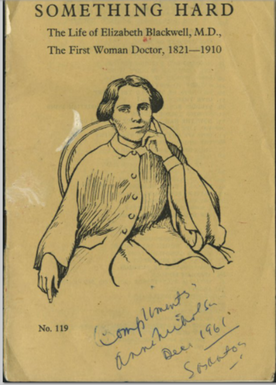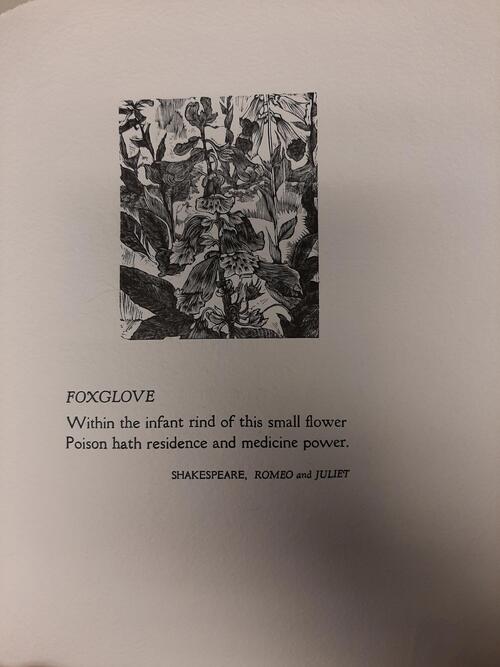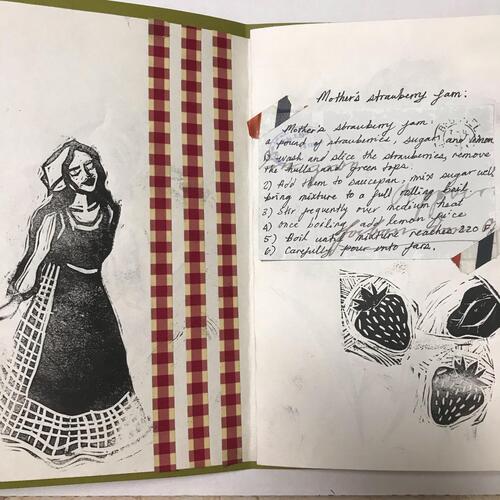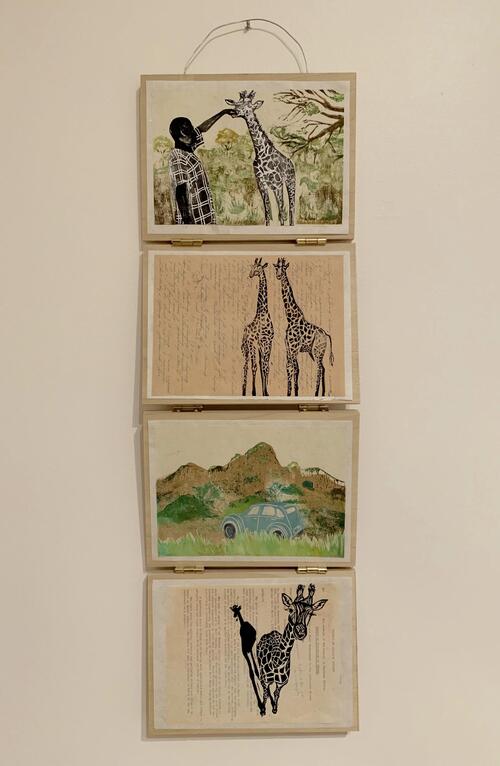Dana Porter Library, first floor
University of Waterloo Library
Waterloo, Ontario N2L 3G1
519-888-4567 x42619 or x42445
FINE 230 & SCA
Each year students from FINE 230 seek inspiration from the materials in Special Collections & Archives to create their prints in a project called "Library as Muse". Although this year has looked a little different, by using resources such as the Waterloo Digital Library students were able to let their imaginations run wild and create some incredible works of art. Thank you to those students who allowed us to feature their art works here; we hope you enjoy them!
Amber Cheung
"Inspired by Elizabeth Blackwell's life as the first female doctor, I made my print of a woman holding a stethoscope with a halo behind her. The plants depicted represent various medicinal plants used in the 1900s. I experimented with different varients of gradients which set the mood for the prints."


![]()
Pat Coustos
" Title: Time to Unfold. This piece is a response to a poem written by Mary Holmes, and published in Maker magazine, which was created by the Federation of Students at the University of Waterloo in 1973. I was particullarly inspired by the line 'time to unfold myself' and wanted to create a print that would reveal itself as it was unfolded and had a sense of space in its unfolded state. The print emerges from a journal, highlighting the personal nature of the text. The image behind the relief print in the journal, is 'reverse' origami instructions (or instructions to create a diamond shape). All text in the print is written by Mary Holmes."

Jill de Rijke
"The inspiration for this project came from the archives, specifically documents from movements surrounding women's health throughout the 1900s. Similarities between issues then and today are highlighted, as well as the many uncomfortable choices left for this with uteruses to prevent or abort pregnancy, ideas typically rooted in men's comfort, at the expense of the female body."


Monika Dinwoodie
"My inspiration for the Library as Muse project was the suffagette movement and how women were starting to shed light on the issues in the world. In a similar way, before the light started to shine, there was darkness in the homes and communities where wrong doing was taking place and secrets were used to keep them hidden and in the dark. With this idea and thought in mind I wanted to pursue a still image of a chandelier for my project, but that wasn't enough for me. I wanted to animate it and make the candle flame come alive."


![]()
Jessica Feng
"Title: Take Daily as Needed. Inspired by the Fritsch Pharmacy fonds at Special Collections & Archives in Dana Porter Library, I chose to create a response to the current pandemic environment on physical and mental health by recreating the medicine boxes with prescriptions of what people need at this time. I utilized the same blue monochromatic colour scheme and some of the design elements found to create the box designs, which I then folded and glued together to create three dimensional boxes. The first prescription is for 1 box of physical activity and exercise at a dose of 150 minutes per week. The text on the box writes 'Feng's compound syrup of physical activity and exercise a reliable remedy for laziness and couch potato syndrome.' The second prescription is for 1 box of sleep remedy at a dose of 8 hours a day. The text on the box writes 'Feng's sleep remedy valuable in the treatment of insomnia and stress.' Both exercise and sleep are two things that I have found really helped me, which is why I chose to make these two prescriptions for the assignment."

![]()

Jazlin Nicholas
"The materials about acid rain from the University of Waterloo archives inspired me for this assignment. I have always liked the saying 'no rain, no flowers' and that was one of the first things that came to mind when I thought about rain. Especially now, during the pandemic, times seem hard and overwhelming but it is important to think about the brighter days of the future"


![]()
Sophie Schneider
"I decided to do a poster print based on the Bauhaus-esque edition (of Euclid's Elements of Geometry) from 1847. Even though I'm in the faculty of math, I've never really been a math person. During my first year here, I was really struggling with understanding the idea of the proof. In this pictorial version of Euclid's elements, they use beautiful artistic and colour figures to write proofs. I wanted to convey a piece that highlighted these beautiful figures but also show that learning math can come in all forms, even artistic ones. This is really a piece that shows how my love of math has grown, with my persistent love of art"


![]()
Jessica Stocks
"For this assignment, I was inspired by the artist bookwork Flora held in the University of Waterloo’s special archives. It has pieces of poetry that describe flowers, as opposed to the flowers’ general information. I grew up around plants, as my mum has a green thumb, so I was super excited to create something similar with my favourite flowers, combining linocut prints in a style inspired by photo negatives. For Black Petunias, I wrote about what they symbolized as well as what they look like. I worked in a garden store a few years ago and when I first saw them, I thought they looked and felt as soft as velvet. Though Dandelions are considered to be herbs, I’ve always thought of them as flowers, and I decided to include it in my collection alongside lyrics from the song “Dandelions” by Ruth B.. It reminds me of when I was little and I’d try to make wishes on dandelions. For Lilacs, I wrote about one of my earliest memories where me and my sister picked the petals off the lilac bush in the garden and put them in the paddling pool, while my mum was busy making our dad’s birthday dinner. And for Sunflowers, I chose to write the poem more in the style of lyrics, as I tend to associate them with music."


![]()
Diana Tran
"Title: Flower Girl. In the summer of quarantine, I stumbled upon a New York Times article talking about the rise of a subculture called “cottagecore.” According to the New York Times, cottagecore is a “calming ethos for our febrile moment” that involved “small animals, calico tea cozies and not a lot of men.” The proliferation of the cottagecore aesthetic was boosted by the current quarantine, which made people feel trapped and stressed by the constant and rapid changes it caused. Cottagecore offered an appealing escape from all of that—replacing it with calming, slower paced activities such as baking fresh bread and tending to the garden. Many of these activities are traditionally seen as household, female duties, but it seems that those who embrace the cottagecore lifestyle have reclaimed it for themselves. It is done for their own enjoyment in the company of their friends rather than a means of domestic servitude for men. When I stumbled across a scrapbook by Maria Louise Clough at the University of Waterloo’s digital archive, I immediately thought of cottagecore—both of which had a romantic sensibility and sense of wonder. The archive description explains that it was a scrapbook which would have given “insights into the activities and tastes of a young woman of that day.” It included ticket stubs, correspondence letters and clippings. My project serves as a modern reinterpretation of that scrapbook, incorporating the current trend of cottagecore which has been so popular with young women. My scrapbook features lino prints of various popular motifs found in cottagecore—including long dresses and bonnets, fruits and flowers, combined with ephemera such as handwritten letters and recipe cards. All the subjects are female which also gives ode to the cottagecore theme. Some of the prints show interactions between two females, which highlights the special bond and relationships that women have with one another."


![]()
Larissa Ward
"World War Two involved and affected so many people around the world. I have taken interest in the stories and memoirs of people who lived through the war. When I saw the picture Wait for me Daddy in the book 100 Photos that Changed Canada by Mark Reid at the rare book collection at the University of Waterloo, I was inspired to create a narrative that told the history and relationship between the boy and the father. This iconic photograph tells the story of many families as they watched men, specifically in this photograph a Canadian father going off to war. The first picture in the series of four is the original photograph taken in 1940 to begin the story to show the departure. Once the father goes off to war, I wanted to show the distance and anguish of missing someone between the boy and the father. One can see in the subsequent prints following the original image that the father is less opaque and slightly faded representing the distance apart between them; it represents the boy's fading memories of his father. The second photo is a letter from the boy to his father. I specifically chose this historical letter as the first line read 'Well only a few days to Christmas...' which gripped me as many of the families thought that their loved ones woud be back for Christmas, but little did they know the war would continue on for much longer. The third print I wanted to capture the places that the father could have been, Juno Beach. The picture shows how the Allies planning the attack on D-day. While this was a great victory for Canadians and for the war effort there was a great loss in this battle, which leads to the next print - the boy and the balloon. the balloon is to symbolize the father drifting away because he died in the great victory for at Juno Beach. The image is also powerful because I wanted to bring it into contemporary art and have a dialogue with Banksy's image, Balloon Girl; while they are very similar, visually, in this narrative it carries a heavy loaded meaning."


![]()
Sarah Wilkins







